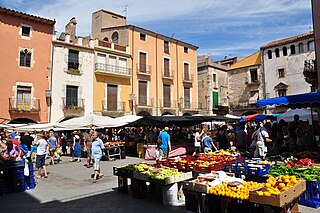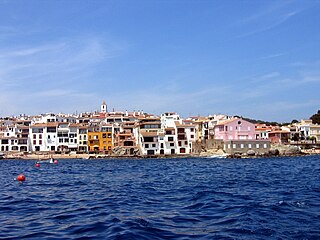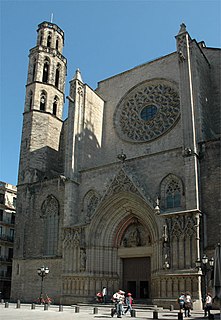Ramon d'Abella (fl. 1389–1401) was a Catalan military leader and royal councillor under John I and Martin of the Crown of Aragon.
Floruit, abbreviated fl., Latin for "he/she flourished", denotes a date or period during which a person was known to have been alive or active. In English, the word may also be used as a noun indicating the time when someone flourished.

John I, called by posterity the Hunter or the Lover of Elegance, but the Abandoned in his lifetime, was the King of Aragon from 1388 until his death.

Martin the Humane, also called the Elder and the Ecclesiastic, was King of Aragon, Valencia, Sardinia and Corsica and Count of Barcelona from 1396 and King of Sicily from 1409. He failed to secure the accession of his illegitimate grandson, Frederic, Count of Luna, and with him the rule of the House of Barcelona came to an end.
During the guerra dels armanyaguesos in 1389, Ramon led a regiment of cavalry in the area around Torroella de Montgrí and Palafrugell. [1] The young poet Guillem de Masdovelles fought under Ramon in these campaigns against Bernard VII of Armagnac and composed a sirventesch dedicated to him. It was probably sometime before this war that Ramon had a falling out with Guerau de Queralt i de Rocabertí.

Cavalry or horsemen are soldiers or warriors who fight mounted on horseback. Cavalry were historically the most mobile of the combat arms. An individual soldier in the cavalry is known by a number of designations such as cavalryman, horseman, dragoon, or trooper. The designation of cavalry was not usually given to any military forces that used other animals, such as camels, mules or elephants. Infantry who moved on horseback, but dismounted to fight on foot, were known in the 17th and early 18th centuries as dragoons, a class of mounted infantry which later evolved into cavalry proper while retaining their historic title.

Torroella de Montgrí is a coastal municipality on the Costa Brava, and small town in Catalonia, Spain. The town lies on the north bank of the Ter river, a few kilometres before it flows into the Mediterranean. The beach resort of L'Estartit also is part of the municipality, as are the Medes Islands and a large part of the Montgrí Massif.

Palafrugell is a municipality in the Mediterranean Costa Brava, located near Palamós in the comarca of Baix Empordà, in the province of Girona, Catalonia, Spain. With 22,365 inhabitants it is the largest city of its comarca. Several coastal and interior towns belong to this city.
In 1392 Ramon purchased the castle of Solivella and its jurisdiction, both high and low, for 16,500 Aragonese sous from John I. From 1395 to 1397 and again from 1398 to 1401 he served as governor of the Kingdom of Majorca. His lieutenant was Berenguer de Montagut.

Solivella is a municipality in the comarca of the Conca de Barberà in Catalonia, Spain.

The Kingdom of Majorca was founded by James I of Aragon, also known as James The Conqueror. After the death of his firstborn son Alfonso, a will was written in 1262 and created the kingdom to cede it to his son James. The disposition was maintained during successive versions of his will and so when James I died in 1276, the Crown of Aragon passed to his eldest son Peter, known as Peter III of Aragon or Peter the Great. The Kingdom of Majorca passed to James, who reigned under the name of James II of Majorca. After 1279, Peter III of Aragon established that the king of Majorca was a vassal to the king of Aragon. The title continued to be employed by the Aragonese and Spanish monarchs until its dissolution by the 1715 Nueva Planta decrees.

Berenguer de Montagut was a Catalan architect, master builder on Santa Maria del Mar.



